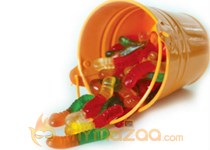It might seem like the children of nutritionists are snacking on broccoli 24/7, but they can be just like any other kids— they’re picky, crave candy, and sometimes refuse to eat dinner.
Yet instead of negotiating, bribing or restricting foods, nutritionists say the key to making sure their kids eat healthy is to offer a variety of foods, build in space for treats and let them make their own choices. Here, read on for eight foods the experts serve their kids.
1. Gummy worms
Every day when they come home from daycare, Tamara S. Melton, an Atlanta-based registered dietitian nutritionist and spokesperson for the Academy of Nutrition and Dietetics (AND) allows her daughters, ages 2 and 3, to have two gummy worms each.
Instead of negotiating for dessert after dinner or making candy off-limits, her kids can have a treat without obsessing over sweets.
“I’m trying to train them that if they want it, they can have it but it’s not something that’s so special that they have to sneak or hoard,” she said.
2. Sardines
Most kids will refuse to eat fish but finding a delicious way to incorporate it into meals can make it more palatable and provide them with an excellent source of protein and omega-3 fatty acids. Sarah B. Krieger, a registered dietitian nutritionist and spokesperson for the Academy of Nutrition and Dietetics in St. Petersburg, Fla., sautés onions, garlic and mushrooms, adds mashed sardines to a tomato sauce and serves it over pasta for her kids, ages 12, 9, and 6.
3. Chocolate soy milk
Krieger also allows her son to drink chocolate soy milk since he’s allergic to cow’s milk and doesn’t like the taste of plain or vanilla soy milk. Since he’s getting calcium, potassium and phosphorous, she doesn’t mind a small amount of sugar.
“It’s a dessert, it fills him up, and it provides nutrition as well,” she said.
4. Seaweed
As a snack, Melton’s daughters enjoy dried wasabi-flavored seaweed strips. Rich in minerals, vitamin B6 and iodine, dried seaweed also has some fiber and is a better alternative to chips. Plus, the wasabi flavor has made her kids more receptive to stronger flavors in other dishes such as cayenne, cumin and ginger.
5. Kefir
Kefir, a fermented dairy product, that is rich in vitamin D, calcium and protein, is the drink of choice at breakfast for Melton’s daughter. Kefir also contains probiotics, which are good for immunity and GI regulation.
Be sure to compare labels because some brands can have as much as 50 grams of sugar per serving. Since some kids dislike the tangy taste of Kefir, look for fruit-flavored varieties or add spinach and your own fresh fruit to plain Kefir for a healthy and delicious smoothie.
6. Jicama
Rebecca Scritchfield, a Washington D.C.-based registered dietitian nutritionist and a health and happiness expert feeds her daughters, ages 3 and 18 months, jicama (pronounced HEE-kah-ma), a crunchy root vegetable that tastes like a cross between a pear and a water chestnut. Jicama is high in vitamin C and potassium and also has iron, calcium and fiber. Cut jicama into sticks and serve it with hummus for a healthy after-school snack, add it to a stir-fry or grate it and fold it into a sandwich.
7. Yucca
Yuca, (pronounced yoo-cuh), is a root vegetable that’s high in potassium and fiber and tastes like potatoes. Cut it up like steak fries, add paprika and roast it or make a healthier version of mashed potatoes with sautéed onions, lime juice and cilantro or some grass fed butter.
“You can use ingredients to make things that are good for you taste even better,” Scritchfield said, who feeds yucca to her daughters.
8. Sourdough bread
Although kids should be getting whole grains in their diets, it’s ok to also include refined grains in sourdough bread or semolina pasta.
“The goal is to have half of the grains be whole grains,” she said.
To avoid a blood sugar crash, try to balance out the meal with protein and fiber from fruits and vegetables.










